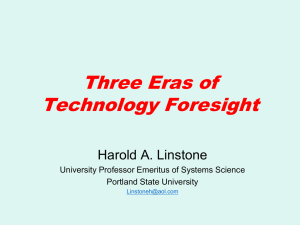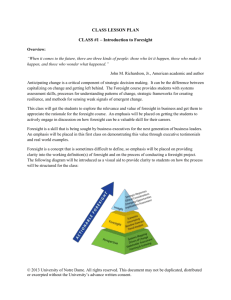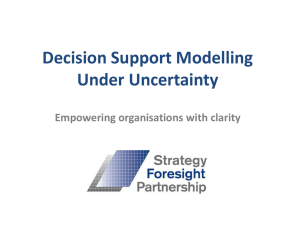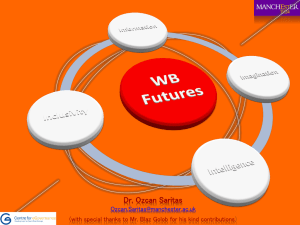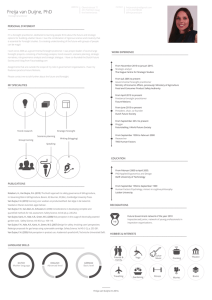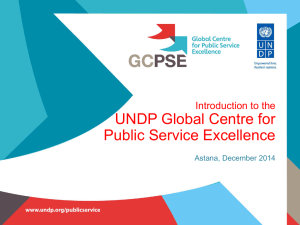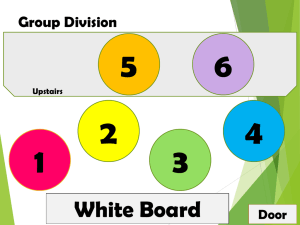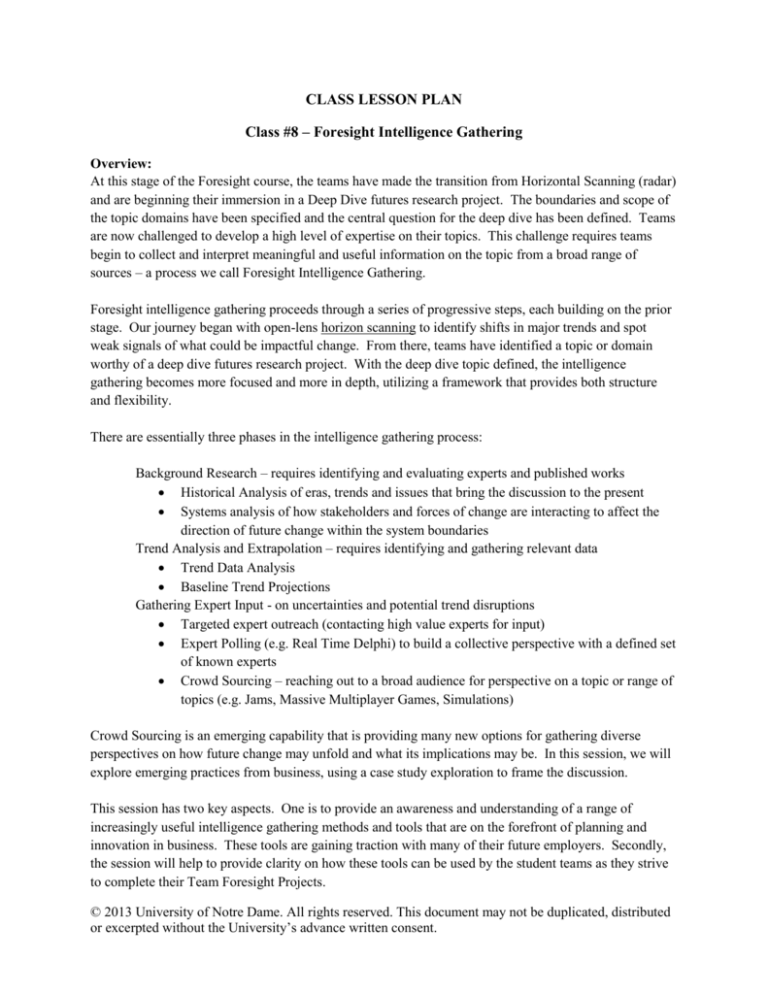
CLASS LESSON PLAN
Class #8 – Foresight Intelligence Gathering
Overview:
At this stage of the Foresight course, the teams have made the transition from Horizontal Scanning (radar)
and are beginning their immersion in a Deep Dive futures research project. The boundaries and scope of
the topic domains have been specified and the central question for the deep dive has been defined. Teams
are now challenged to develop a high level of expertise on their topics. This challenge requires teams
begin to collect and interpret meaningful and useful information on the topic from a broad range of
sources – a process we call Foresight Intelligence Gathering.
Foresight intelligence gathering proceeds through a series of progressive steps, each building on the prior
stage. Our journey began with open-lens horizon scanning to identify shifts in major trends and spot
weak signals of what could be impactful change. From there, teams have identified a topic or domain
worthy of a deep dive futures research project. With the deep dive topic defined, the intelligence
gathering becomes more focused and more in depth, utilizing a framework that provides both structure
and flexibility.
There are essentially three phases in the intelligence gathering process:
Background Research – requires identifying and evaluating experts and published works
Historical Analysis of eras, trends and issues that bring the discussion to the present
Systems analysis of how stakeholders and forces of change are interacting to affect the
direction of future change within the system boundaries
Trend Analysis and Extrapolation – requires identifying and gathering relevant data
Trend Data Analysis
Baseline Trend Projections
Gathering Expert Input - on uncertainties and potential trend disruptions
Targeted expert outreach (contacting high value experts for input)
Expert Polling (e.g. Real Time Delphi) to build a collective perspective with a defined set
of known experts
Crowd Sourcing – reaching out to a broad audience for perspective on a topic or range of
topics (e.g. Jams, Massive Multiplayer Games, Simulations)
Crowd Sourcing is an emerging capability that is providing many new options for gathering diverse
perspectives on how future change may unfold and what its implications may be. In this session, we will
explore emerging practices from business, using a case study exploration to frame the discussion.
This session has two key aspects. One is to provide an awareness and understanding of a range of
increasingly useful intelligence gathering methods and tools that are on the forefront of planning and
innovation in business. These tools are gaining traction with many of their future employers. Secondly,
the session will help to provide clarity on how these tools can be used by the student teams as they strive
to complete their Team Foresight Projects.
© 2013 University of Notre Dame. All rights reserved. This document may not be duplicated, distributed
or excerpted without the University’s advance written consent.
Learning Objectives:
Gain an awareness of the range of tools and methods commonly used to gather and assess
intelligence regarding future change
Understand the types of sources for background research and the pros/cons for each
Understand the value and limitations of historical (trend) analysis in projecting future change
Gain an awareness and understanding of foresight techniques for gathering expert
perspectives to support foresight forecasting efforts
Evaluate how this range of foresight tools and methods can be used by student teams to
advance the student foresight project
Key Terms and Concepts:
Background Research
Trend Analysis and Extrapolation
Forecasting
Focused Expert Outreach
Expert Polling
Real Time Delphi
Crowd Sourcing
Collective Intelligence
Massively Multiplayer Online Gaming
Modeling and Simulations
Class Preparation:
Readings:
“An Overview of Futuring Methods” Excerpt from Chapter 6 of “Futuring – The Exploration of
the Future” by Edward Cornish
Assignment Due:
Scanning Posts - Round #1, due ____________________.
© 2013 University of Notre Dame. All rights reserved. This document may not be duplicated, distributed
or excerpted without the University’s advance written consent.
INTRUCTOR GUIDELINES
Discussion Questions with Answers:
Why is it important for scanners to critically assess to their “hits” as they scan? What principles
of critical assessment can be helpful?
A: Scanning requires an open lens to environmental signals from all types of sources. This is a
good thing because it brings information from a variety of points of view and areas of expertise.
The challenge is that these scanning hits may contain bias, lack evidence for support, or may
offer faulty assumptions or logic in support of their arguments/conclusions. So applying
thorough critical assessment is essential.
The principles that can be useful in applying critical assessment are as follows: self-awareness
(of your own biases and preconceptions); keeping an open mind to other points of view; applying
the effort and discipline to go beyond taking the argument at face value; skepticism that the
source may have an agenda; and judgment on whether the argument fits.
What is the purpose of categorizing scanning hits?
A: Classifying scanning hits can be useful in helping the scanner interpret and make use of the
hits. In addition to considering the DEGEST categories for scanning hits, it can be useful to
consider the type of hit itself. For the Scanning Post assignment in this class, students are
expected to classify their hits into the following categories:
o
o
o
o
o
o
o
Evidence of Linear/Continuous Change
An Event the may cause a Temporary (~1 year Disruption)
An Event that may cause a Permanent/Structural Disruption
Leading Indicator (weak signal) of a disruptive innovation (New S-Curve)
Example of Unexpected Consequence of Change
Example of an Initiative to Shape change
Example of an Initiative to Adapt to change
As you approach the next phase of your foresight project, what types of foresight intelligence
gathering tools will be most useful for your team in defining specific future outcomes? Be
prepared to discuss 1-2 ideas on strategies your team can use to take advantage of these tools.
A: Each foresight project is unique, so there will be no cookie cutter approach to the use of
foresight techniques and methodologies. The goal is to provide a robust consideration for each
section of the process (current assessment, expected and alternative forecasts, and implications
assessment). So each team should be aware of the full range of methods at their disposal and be
able to provide a strong rationale as to why the methods they have selected are justified for their
particular project.
© 2013 University of Notre Dame. All rights reserved. This document may not be duplicated, distributed
or excerpted without the University’s advance written consent.
Class Timeline:
5 Minutes – Intro and Quote of the Day
10 Minutes – Go Over Results of Quiz 1
25 Minutes – Scope of Project elevator speeches (See below)
20 Minutes – Overview of Foresight Intelligence Gathering Methods
10 Minutes – Intelligence Gathering for the Team Foresight Projects
5 Minutes – Wrap Up and Preview of Upcoming Class
The first 25 minutes of this class will be used for student teams to present their elevator speeches on their
Scope of Project Briefs. Each team will present a 3 minute pitch describing:
1.
2.
3.
4.
What is their central question?
What is driving change (across DEGEST categories)?
How is this change relevant to business and society?
Why is it relevant to your team?
Classroom Activities/Short Assignments:
Elevator speeches on the Scope of Project Briefs will be presented at the beginning of class. Student
teams will be expected to present a 2 minute elevator pitch answering:
1.
2.
3.
4.
What is their central question?
What is driving change (across DEGEST categories)?
How is this change relevant to business and society?
Why is it relevant to your team?
Multimedia Supplements:
Examples of gaming and simulations from web:
IBM CityOne game
Energy City
Notes and Perspectives:
© 2013 University of Notre Dame. All rights reserved. This document may not be duplicated, distributed
or excerpted without the University’s advance written consent.

